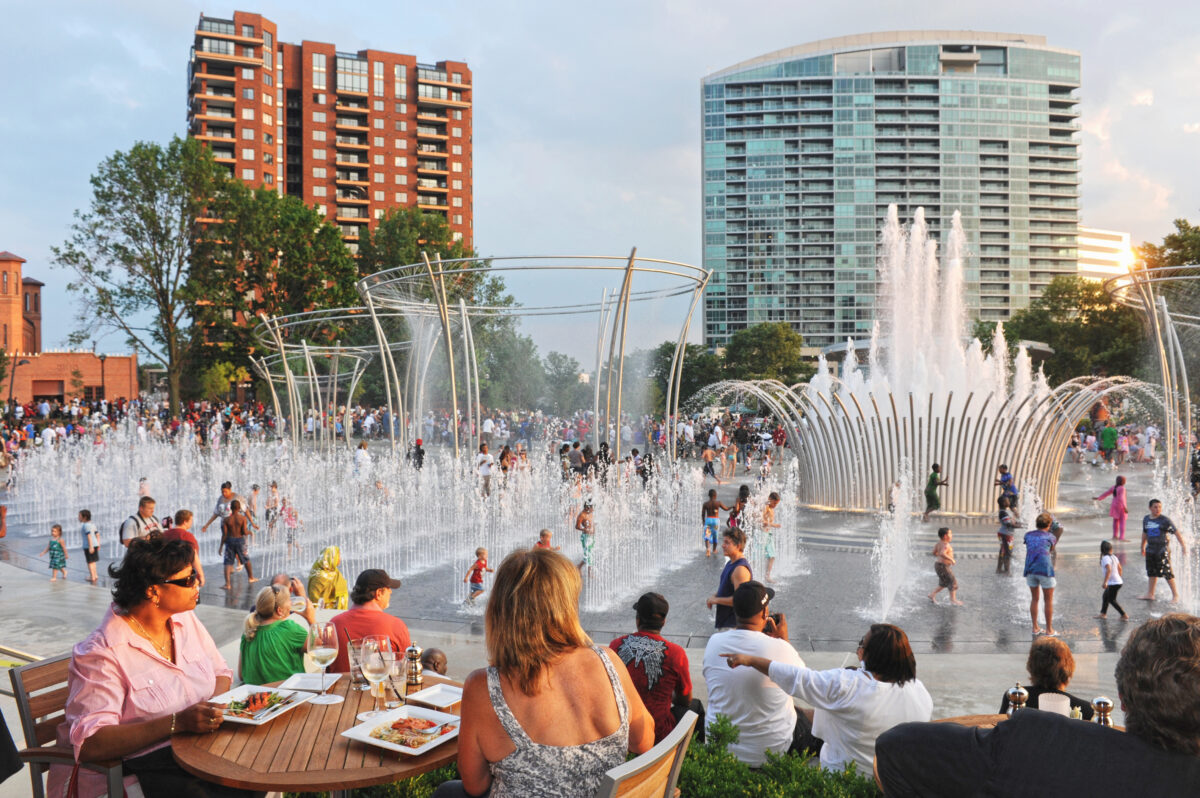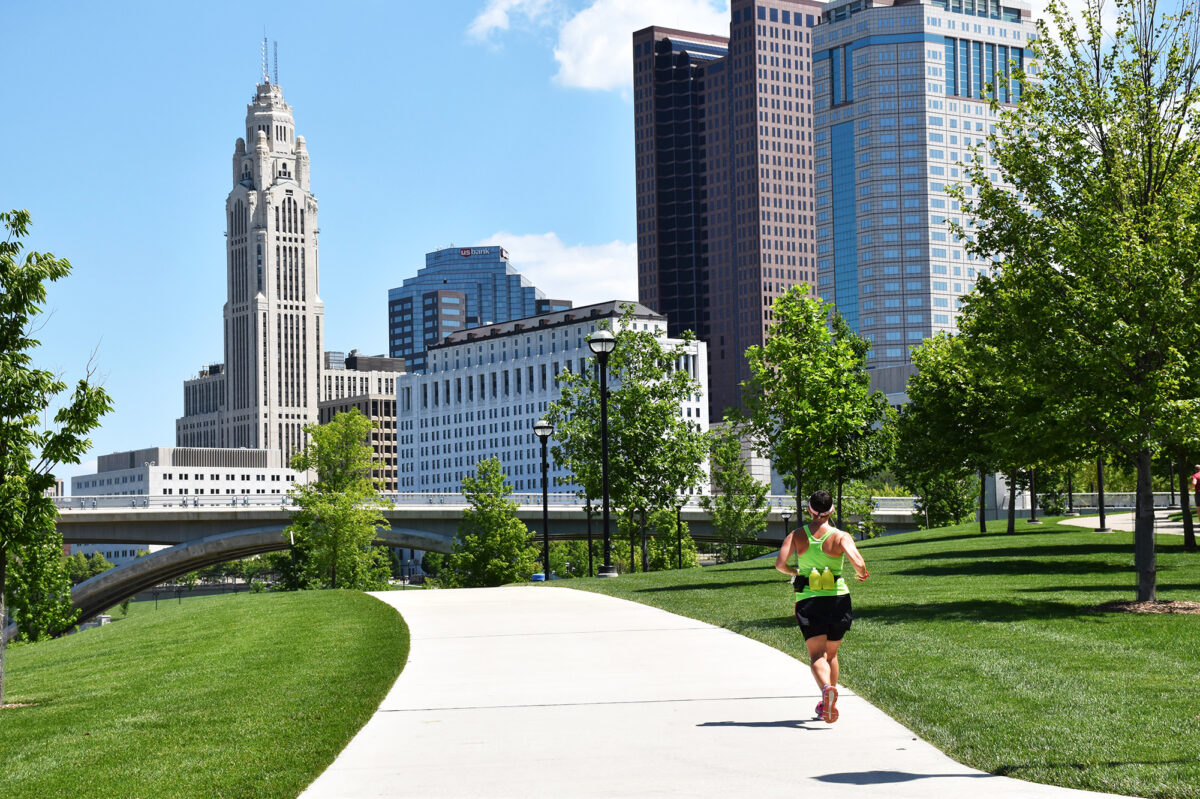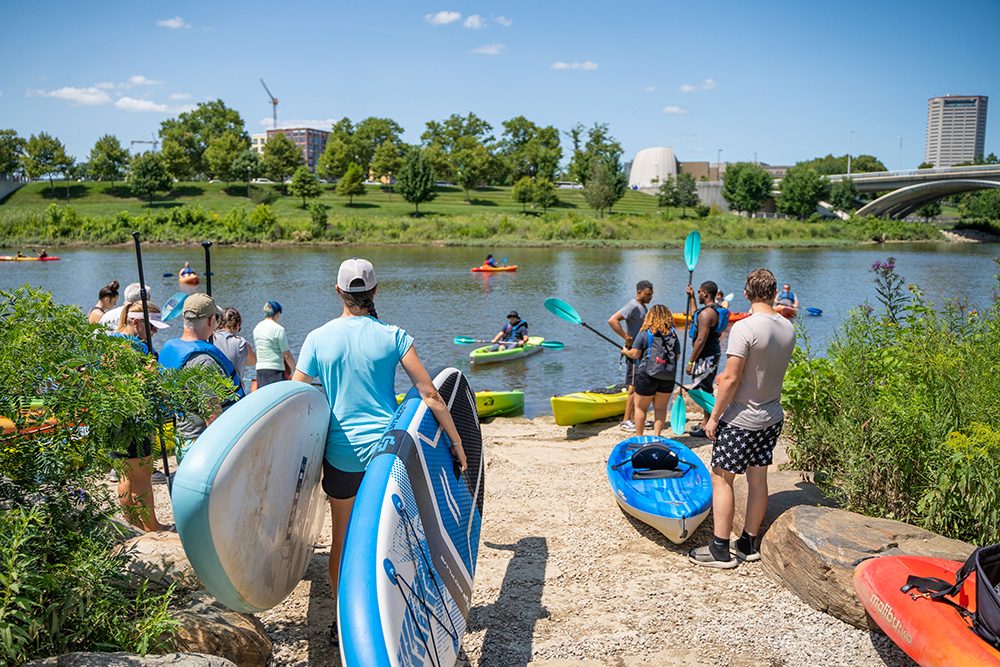Home » Projects & Initiatives » Scioto Riverfront




Looking at it now, it’s hard to believe that the Scioto Mile hasn’t always been a focal point in Downtown Columbus. To the contrary, the project transformed an aging, neglected civic resource into a vital network of public green spaces. It reconnected Downtown to the Scioto River with an integrated system of parks, boulevards, bikeways, and pedestrian paths.
Before construction began on the Scioto Mile in 2008, Civic Center Drive was a five-lane highway that served as a bustling pipeline to move employees out of Downtown. The beauty of the Scioto River was ignored as drivers blitzed past the riverfront at high speeds. Following the conversion of the street into one lane in either direction, the passage has since become a calming, pedestrian-friendly corridor. The Scioto Mile’s Promenade wraps along the river from Broad to Rich streets and showcases a series of water features, benches, swings, gardens, and tables. Special attention was paid to incorporating historical elements such as the Town Street Prow and restoring the beaux-arts limestone carvings of the Promenade balustrade.
At the south end of the Scioto Mile, stands the John W. Galbreath Bicentennial Park. The park was updated with three world-class elements that attract visitors by the thousands; a signature fountain that is currently being reimagined for the next generation of Scioto Mile splashers, an eye-catching bandshell and Milestone 229 restaurant overlooking it all.
The Scioto Mile is a model of the type of successful public-private partnership for which Downtown Columbus, Inc. is renowned. Completed on budget for a cost of $44 million, half of the project was funded from public sources and half was funded with investment from the private sector. Further, the Scioto Mile Endowment helps provide for the ongoing maintenance and upkeep of the Scioto Mile. As a result of this forethought, the Scioto Mile will remain an amenity to be enjoyed by Downtown Columbus residents, workers, and visitors for years to come.
The concept for Scioto Greenways was first presented to Columbus as part of a comprehensive public process that ultimately resulted in the 2010 Downtown Strategic Plan. Of all the ideas presented to the community in the Strategic Plan, Idea #12 (the Scioto Greenways) became priority #1. The City of Columbus engaged Downtown Columbus, Inc. to develop and execute the comprehensive project plan for the Greenways. Following a feasibility study, Downtown Columbus, Inc. secured $36 million in funding from generous public and private partners.
Scioto Greenways consisted of three primary components: 1) Removal of the low-head Main Street Dam, 2) Restoration of the Scioto River channel to its natural width, and 3) The creation of 33 acres of new urban greenspace complete with 1.5 miles of multi-use pathways, nearly 800 trees and more than 75,000 plant features. In November 2013, the project began, and working against an aggressive 24 month schedule, during a period of record-low temperatures and record rainfalls, the Scioto Greenways made its public debut right on time in November 2015.
As a result of these projects, the river’s natural ecosystem is healthier today than ever before. It has become an accessible urban amenity for Downtown’s residents, professionals and visitors. Today, visitors to the Scioto Mile can stroll, ride or run along multi-use pathways that are wide enough to accommodate two-way traffic; pause to take in the views at Coleman’s Pointe or the Lower River Walk; lounge on the lush lawns; hit the water on a kayak, canoe or paddle board at one of four launches; take part in dozens of free events that take place on the mile, or simply claim a space to rest on one of the many benches within the park.
2019 ULI Global Award for Excellence, Scioto Peninsula Cultural District
2017 Experience Columbus EXPY Award, Downtown Riverfront
2017 ACEC Ohio Engineering Excellence Award, Scioto Greenways
2016 American Planning Association National Planning Excellence Award for Implementation, Downtown Columbus Riverfront
2016 IDA Downtown Achievement Awards Certificate of Merit, Downtown Columbus Riverfront
2016 Harrison W Smith Award, Scioto Greenways
2016 Capital Crossroads Special Improvement District Outstanding Achievement Award, Scioto Greenways
2016 APWA Project of the Year Award (Environment), the Scioto Greenways
2016 Ohio Chapter of the American Society of Landscape Architects Award of Excellence, Scioto Greenways
2014 ULI Open Space Award Finalist, Columbus Commons and the Scioto Mile
2012 IDA Pinnacle Award for Public Space, the Scioto Mile
2011 Ohio Parks and Recreation Association First Place, the Scioto Mile
2011 Harrison W Smith Award, the Scioto Mile
Downtown Columbus Inc. is a private, non-profit development corporation with a mission to lead city-changing projects in the heart of Ohio’s capital city. Downtown Columbus Inc. was created in 2002 to implement the Downtown Strategic Plan.
© 2024 Downtown Columbus Inc. Check out our Privacy Policy and Terms of Use.
 Powered by Buckeye Innovation
Powered by Buckeye Innovation